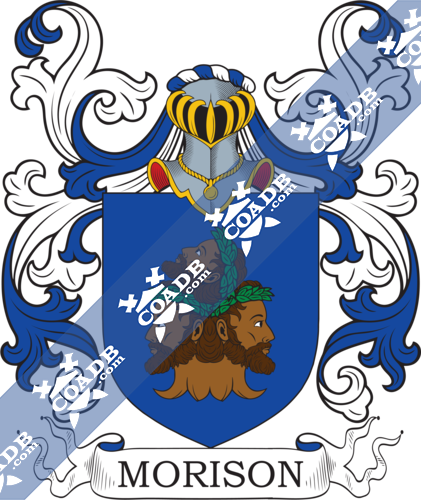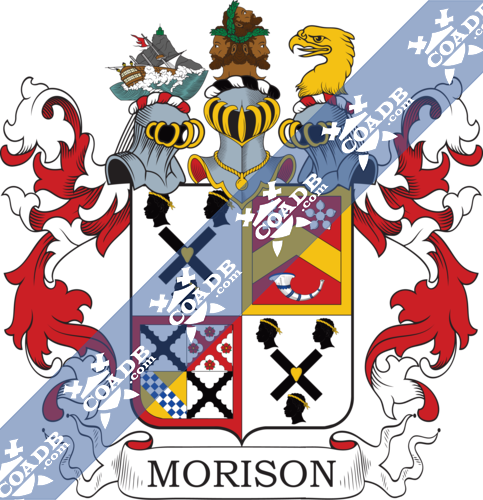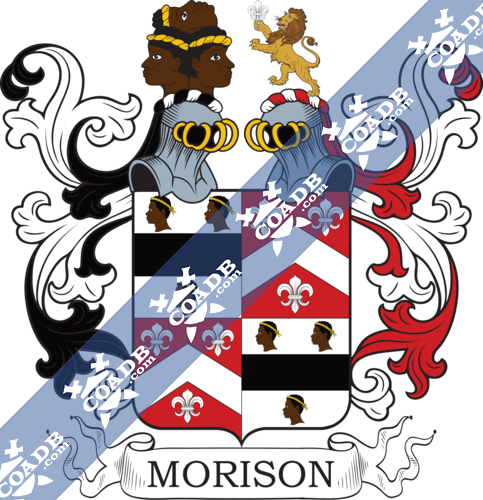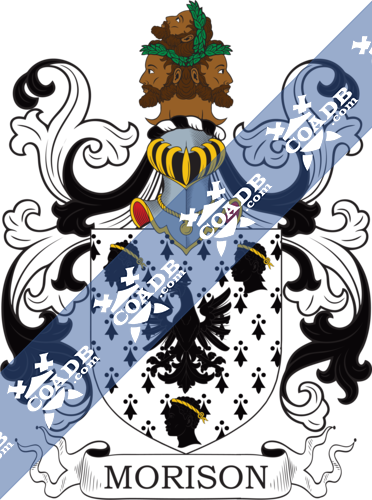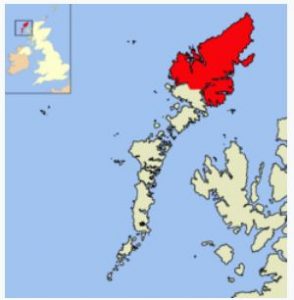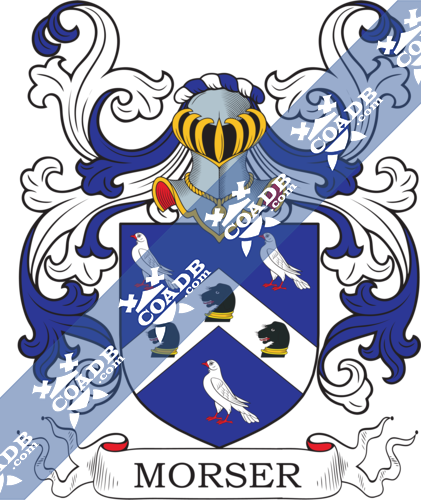Morrison Family Crest, Coat of Arms and Name History

Morrison Coat of Arms Gallery
Don’t know which Coat of Arms is yours?
We can do a genealogical research. Find out the exact history of your family!
Learn More
Morrison Meaning, Origin & Etymology
The name Morrison, or Morison, is patronymical and means ‘son of Maurice’. Maurice comes from the Latin ‘Mauritius’, a personal name which means ‘dark’. It is most likely of Scottish origin, and is also popular in Ireland. The martyrdom of St. Maurice in 286 AD likely helped the popularity of Morris as a given name when it was later introduced by the Normans.
There are a number of legends that point to the origin of the Morrison clan in Scotland. One claims that their Norwegian forefathers were shipwrecked just off the Isle of Lewis and were saved by clinging to driftwood; it is said that this disaster led to the incorporation of driftwood into the clan badge. Another legend, which could be connected, states that the Morrisons are descended from the O’Muircheasain bards of the Outer Hebrides. Yet another claims that the Morrison clan is directly related to the mysterious King Somerled, King of the Isles, who died at the Battle of Renfrew in 1164. The name was reportedly found first on the Isle of Lewis where the chiefs of the clan were positioned as the Judges of Lewis in the ‘Tigh Mor’’ or ‘big house’ at the northernmost point of the island. That they were descended from King Somerled is not inconceivable, as lines can be drawn to Caedhain MacMhuirich of the Donald clan and Gillemoire of the MacLeod clan. Both these men were princes of the Norse Empire of the Isle of Man and the Hebrides, and MacMhuirich certainly was descended from Somerled.
Guppy’s 1890 manuscript ‘Homes of Family Names in Great Britian’ claims that the name ‘Morris’ has several origins, and comes principally from the counties that border Wales, except Cheshire. He says that separate branches may have originated independently in Buckinghamshire, Leicestershire and Nottinghamshire, and that there is clearly another origin to be found in Hampshire, where Morris’s can be found in high frequency. He suggests that Morrison is almost exclusive to Scotland, being found only sporadically in Northumberland, northern England.
Arthur’s ‘An Etymological Dictionary of Family and Christian Names’ states that Morris comes from the Welsh ‘Mawr’ and ‘rys’ meaning a hero, warrior or brave man.
Burke states that ‘Morris’ has 2 origins – one being that it was brought to Britain as part of the Norman conquest, and one that it is of Welsh descent. It is suggested that one of the foreign sources is of Moorish origin (similar to Morris) and came from Africa through Spain and thus to northern Europe, and that it is connected to the English ‘Morrice’ (morris) traditional dance. He suggests that the name may be a corruption of Mars or Mavors, the god of war.
Lower adds the possibility that Morris may have derived from the French ‘Du Marais’, in Latin ‘De Marisco’ – translated as ‘of the marsh’.
Variations
Early British names suffered from a mix of languages and no set spelling rules. Scribes often transcribed names phonetically, and as such many names are recorded with a huge range of spellings. Direct variations of the name Morrison include Morison, Morris, Morriss, Morrish, Morrice, Morse, Morss and Morice. Similarly spelled names which may share the same origin include, but are not limited to, the following: Morrijson, Morroison, Morrisone, Morrisoin, Moorrison, Mmorrison, Morrisonn, Morrisohn, Morrieson and Morrisson.
Popularity & Geographic Distibution
Some 285,327 people bear the name Morrison, making it the 1,913th most common surname worldwide. Of these, a staggering 135,812 Morrisons reside in the USA. Though 12,293 Morrisons live in California, it is the state of Maine which boasts the highest frequency, as 1 in every 1,144 people here carry the name.
The highest frequency worldwide can be found in the Falkland Islands, where 1 in every 300 people bear the surname Morrison.
The name is still hugely popular in Scotland, whence it originated, and is the 4th most popular surname in both the areas of Perth & Kinross and Clackmannanshire.
Early Bearers
The first literary recording of any version of the name is personal, and belongs to Mauricius de Edligtona, who was mentioned in the ‘Social and Economic Documents of London’ in 1176. It was first recorded as a surname in England in the 1379 ‘Poll Tax Records of Yorkshire’, where a Robert Morisson is mentioned during the reign of Kind Edward I (1272-1307). In Scotland, the name first appears with Andreas Morison, a St. Andrew’s lawyer who is mentioned in a Brechin church register in 1463. Other early bearers of the name include Nicol Moryson of Ruchtven, who was recorded in Scotland in 1501 and Charles Morrison, who in around 1752 was the first to suggest electricity as a means of communication.
History, Genealogy & Ancestry
Bernard Burke’s ‘The Landed Gentry…’ discusses 2 branches of the Morison name: Morison of Finderlie Lodge and Morison of Bognie. Alexander Morison Esquire of Bognie and Frendraught, Aberdeen, is recorded as marrying Jessie Duff of Hatton in 1836. Of Morison of Finderlie Lodge, Burke says that one Peter Broun of Balquarhan, Stirling, acquired the lands of Finderlie at the end of the 16th century. He passed his estate to his son, John Broun, who in turn had 2 sons, the elder of which became John Broun of Finderlie. This John Broun married Janet Stevenson of Cocklaw, Fyfe, in 1711 and passed Finderlie estate to his eldest son Ebenezer Brown Esquire. Ebenezer married the daughter of Thompson of Seggie, Kinross, and also purchased the lands of Brockley, which along with Finderlie he passed on to his son John Brown Esquire. John Brown Esquire married Anne, daughter of Beveridge of Wester Balado, and their son James took over the estate upon his father’s death in 1830. Their son Reverend Jamed Brown of Finderlie married Mary Neill, daughter of Reverend Doctor Hay in 1838. He died in 1846, leaving his estate to his only son John Brown Brown-Morrison Esquire of Finderlie. John Brown Brown-Morrison Esquire of Finderlie Lodge was born in 1840 and married Eve Magdalen, daughter of George Waugh Esquire of Queensborough Terrace London in 1864. They had the following issue: Guy Edward, Valentine Dudley Oglivy, Basil, Maud, Muriel, Gwendolen and Blanche Amèe.
Burke also discusses Charles Morrison Esquire of Basildon Park, Berkshire. He says that one Joseph Morrison married a woman named Sarah and had a son, James Morrison Esquire of Hampshire. James was the head of the firm Morrison, Dillon and Co. of Fore Street, London, and acquired by purchase a great deal of land in Berkshire, Buckinghamshire, Kent, Wiltshire, York and Islay. He became M.P. for Ipswich in 1832, but not before marrying Mary Anne, daughter of John Todd Esquire of London, in 1814. Together they had the following issue: Charles, Alfred, Frank, Henry, Walter, George, Allen, Lucy, Emily and Ellen. Their son Charles Morrison was born in 1817 and took over his father’s estate in 1857.
One John Morison was born in Edinburgh, Scotland, in 1520. He married Beatrix Hill in 1537 and they had a son, John Morrison, in 1555. John Morrison married Katherine Margaret Preston and they had the following issue: Harie, Alexander, Henry, Isaac, Elizabeth (Dick), Sarah, Catherine and Helenore. Their son Sir Alexander Morrison was born in 1579. He married Helenor Maule in 1610 and they had the following issue: Bethia (Spotswood), Catherine (Beatoun), Alexander, Helenor, Elizabeth, William, John, James and Robert. Their son Sir Alexander Morrison, the 5th Baron of Prestongrange, was born in 1616, married Jean Boyd in 1634 and fathered Catherine, Helen, Thomas and William. His son William Morrison of Preston Grange was born in 1663 and married Janet Rocheid in 1684. They had the following issue: Alexander, Catherine (Sutherland), Jean, Helen and William. Their son William Morison was born in 1700.
One of Sir Alexander and Helenor’s other sons, James Morrison, was born around 1629. He married Jonet Gordon in 1659 in Edinburgh and they had the following issue: William, Rachel and Thomas. Their son William Morison was born in 1660 and married Christian Thomson in 1690. They had the following issue: Alexander, William, Jean Twin, Joan Twin, James, Andrew, Giles, John and Robert. Their son James Morrison was born in 1698 and married a Janet Sword. They had 4 children: Ann, Gavin, William and Janet.
Another John Morison was born around 1520, and fathered Alan MacIain, Angus, Donald, Kenneth and Malcolm MacIain. His son Donald Morison fathered another Donald Morison sometime before 1620 on the Isle of Lewis. This Donald married Jean Lauder and they had the following issue: ‘Unknown’ Mackenzie, Kenneth and Allan. Their son Reverend Kenneth Morison was born around 1647 and fathered 7 children: Alexander, Anne (Campbell), Murdo, Christian, Janet (Matheson) and Margaret (MacAulay). He died in 1720 on the Isle of Lewis.
Daniel Morrison, one of the early settlers of the American colonies, was born around 1645 and married Hannah Griffin. Upon settling in Newbury in 1690 they had the following issue: Daniel, John, Hannah, Ebenezer and Mary. Their son Daniel Morrison Jr was born in 1691 and married Eleanor Littlefield in 1715 in Maine. They had the following issue: Daniel and Tabitha. Their son Daniel Morrison 3rd was born in 1716 and married Mary Nason. They had 2 children, Mary (Welch) and Edward. Their son Edward Morrison was born in 1761, married Elizabeth Betsey Ham in 1799 and died on the 26th of March 1844 in Shapleigh, Maine.
Early Settlers
Early Settlers of the ‘New World’ who carried the Morrison name include Henry Morrison, who landed in Virginia in 1648; Francis Morrison, who settled in Virginia in 1650; Donald Morrison, who landed in New Jersey in 1685; Andrew Morrison, who was recorded in New Haven in 1690; and Daniel Morrison, who was recorded in Newbury in 1690.
Mottoes
The Morrison name carries 1 motto, ‘vincit veritas’, which translates as ‘truth conquers’.
The name Morison has 3 mottoes, depending on region: ‘Uno ictu’ (by one blow, ‘prudentia præstat’ (prudence excels) and ‘pretio prudential præstat’ (prudence is better than profit).
The name Morris has 10 mottoes, depending on specific branches of the family: ‘A gair Duw yn uchaf’ (the word of God above all); ‘aut pax aut bellum’ (either peace or war); ‘bibl’ (the bible); ‘dum spiro spero’ (while I have breath I have hope); ‘irrupta copula’ (the tie unbroken); ‘marte et mari faventibus’ (war and wave favouring), which is said to relate not only to the name of Morris, but also to various actions of bravery performed by members of the family in war, on both land and sea; ‘scuto fidei’ (by the shield of faith), which belonged to a Morris baronet; ‘sic his qui diligunt’ (thus to those who love), which was emblazoned on a crest featuring a nested pelican feeding her young; ‘spectemur agendo’ (let us be viewed by our actions); and ‘pro rege semper’ (for the King always).
Grantees
We have 14 coats of arms for the Morison surname depicted here, as well as 5 for Morrison. These 19 blazons are from Bernard Burke’s book The General Armory of England, Ireland, and Scotland, which was published in 1848. The bottom of this page contains the blazons, and in many instances contains some historical, geographical, and genealogical information about where the coat of arms was found and who bore it.
Notables
Notable people through history who have carried the Morrison name include, but are not limited to, the following: Richard James Morrison (1795-1874), an English astrologer who won a court case against Admiral Sir Edward Belcher who accused him of fraudulent crystal-gazing; Alexander Morrison (1849-1913), a Scottish-Australian immigrant who was the first Government Botanist of Western Australia; Sir George Ivan ‘Van’ Morrison (1945-present), the Northern Irish singer-songwriter, whose big hit ‘Brown Eyed Girl’ curiously only reached number 10 on the ‘Billboard Hot 100’; and Barb Morrison (1967-present), an American music producer who is known for her work with Blondie, Rufus Wainwright and Franz Ferdinand.
Notable people through history who have carried the Morison name include, but are not limited to, the following: Robert Morison (1620-1683), a Scottish botanist who developed the first systematic classification of plants; Samuel Eliot Morison (1887-1976), an American historian and twice winner of the Pulitzer Prize; Elsie Morison (1924-2016), an Australian soprano who appeared as an oratorio singer all over Europe; and Steven William ‘Steve’ Morison (1983-present), an English footballer, currently playing as striker for Millwall and Wales’ international squad.
Blazons & Genealogy Notes
2) (co. Lancaster). Or, on a cross sa. five fleurs de-lis ar. Crest—Out a ducal coronet or, an eagle’s head and neck betw. two wings displ. ar.
3) Or, on a cross sa. five fleurs-de-lis of the field. Crest—A cubit arm in armour holding a branch of oak all ppr.
4) (Sir Richard Morrison, knighted at Dublin by Robert, Earl of Essex, Lord-Lieutenant, 5 Aug. 1599). Ar. on a cross sa. five fleurs-de-lis or, in the dexter quarter a martlet az.
5) (Coolegegan, in the King’s co.; confirmed to Richard Fielding Morrison, Esq., and the descendants of his grandfather, Sir Richard Morrison, Vicc-Pres. Royal Institute of Architects of Ireland). Or, on a cross per cross sa. and gu. four fleurs-de-lis ar. in the first quarter a crescent of the third. Crest—On a mural crown gu. an eagle’s head and neck betw. two wings displ. ar. the neck and each wing charged with a fleur-de-lis sa. Motto—Utile et dulce.
6) (Standon, co. Herts, and Cadby, co. Lincoln). Or, on a cross sa. five fleurs-de-lis of the field. Crest—Out of a ducal coronet or, an eagle’a head betw. two wings endorsed ar.
7) (London). Per saltire or and gu. in pale two pelicans of the first, in fess as many leopards’ faces of the second, on a chief or, three chaplets gu.
8) (Dairsic, co. Fife, Scotland). Az. three Saracens’ heads erased, conjoined in one neck, and wreathed with laurel ppr. the faces looking to tho chief, dexter, and sinister sides of the shield.
9) (Edinburgh, cadet of Dairsic, 1672). The same, betw. two falcons’ heads couped az. Crest—A serpent ppr. Motto—Prætio prudentia præstat.
10) (Bognie, co. Aberdeen). Az. three Saracens’ heads erased, conjoined in one neck, the faces looking to the chief, dexter, and sinister sides, the uppermost head affixed by a wreath to the other two. Motto—Sunt tria hæc unum.
11) (Prestongrange, co. Edinburgh). Ar. three Moors’ heads couped sa. two and one, banded of the first. Crest—Three Saracens’ heads conjoined in one neck, their faces looking to the chief, dexter, and sinister sides ppr.
12) Ar. on a chief gu. three estoiles or.
13) Ar. three bucks’ heads sa.
14) (Major Alexander Morison, H.E.I.C.S., 1806). Erm. an eagle displ. sa. betw. three Moors’ heads of the last banded or. Crest—Three Saracens’ heads erased, conjoined in one neck, and wreathed with laurel ppr. the faces looking to the chief, dexter, and sinister. Motto—Pretio prudentia praestat.
15) (Duncan-Morison, of Naughton, co. Fife, 1853). Quarterly, 1st and 4th, ar. a saltire couped sa. charged with a man’s heart or, betw. three Moors’ heads couped of the second, banded of the third, for Morison; 2nd, gu. a chev. or, betw. two cinquefoils in chief ar. and a huntinghorn in hase of the last garnished az. all within a bordure of the second, for Duncan; 3rd, the quartered coat of Haldane, of Gleneagles [which see] within a bordure gu. Crests—1st : Three Saracens’ heads conjoined in one neck, erased and wreathed with laurel ppr. looking to the chief dexter, and sinister sides; 2nd: A ship in distress in the sea ppr.; 3rd : An eagle’s head erased or. Mottoes—Pretio prudentia præstat: Disce pati; and, Suffer.
16) (Walker-Morison, of Falfield, co. Fife, 1854). Quarterly, 1st and 4th, ar. a lion ramp. gu. betw. three Moors’ heads couped sa. banded or, for Morison; 2nd and 3rd, or, three pallets gu. surmounted of a saltire wavy ar. on a chief az. a demi lion holding betw. his paws a fleur-de-lis of the third betw. two cushions of the field. Crests —Three Saracens’ heads conjoined in one neck ppr. their faces looking to the chief, dexter, and sinister, a serpent ppr., for Morison; a greyhound courant ppr., for Walker. Mottoes—Prætio prudentia præstat, for Morison; Fac et spera, for Walker.
17) (Touch House, Stirling, 1851). Ar. three Saraccns’ heads couped sa. banded of the first, within a bordure engr. az. charged with three fleurs-de-lis or. Crest—Three Saracens’ heads conjoined in one neck ppr. their heads looking to the chief, dexter, and sinister. Motto—In Deo confido.
18) (Brown-Morison, of Finderlic, co. Kinross, and Coupar Grange, co. Fife, 1866). Quarterly, 1st and 4th, ar. a fess sa. betw. three Moors’ heads couped ppr. banded or, for Morison; 2nd and 3rd, gu. a chev. betw. fleurs-de-lis ar., for Brown. Crests—Three Moors’ heads conjoined in one neck ppr. banded or, the faces looking to the chief, dexter, and sinister, for Morison; A lion ramp. ppr. holding in its dexter fore paw a fleur-de-lis ar., for rown. Mottoes —Prudentia præstet, for Morison: Floreat majestas, for Brown.






